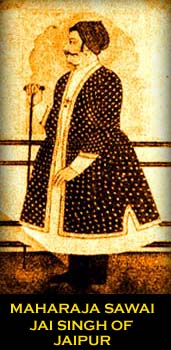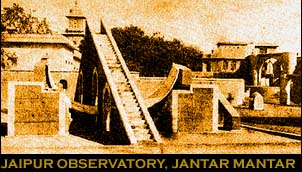Jantar Mantar
Woman of the lens
Corporate Collectors
Repute
Visual encounter
Sale
Feedback
Cover page

"Maharaja Sawai Jai Singh II of Jaipur, was born in AD 1686 and succeeded to the Amber territory at the age of thirteen in AD 1699, a few years before the death of Aurangzeb. He had difficulties in establishing himself, but in 1708 obtained complete possession of the province. In 1719 he was appointed by Muhammad Shah governor of the province of Agra and soon after to Malawi. In 1734 he was again governor of Malwa and in that year, apparently with the cognizance of the Emperor, he resigned the province to the Peshwa. He died in 1743, two hundred years after Copernicus, and "his wives, concubines, and science expired with him on his funeral pyre."
Jai Singh distinguished himself more as a statesman than a soldier and has been termed the Machiavelli of his day. He was the founder of a new capital, named after him- Jainagar or Jaipur, which in his time became a center of learning; he erected caravansaries in many of the provinces and he built astronomical observatories at five of the principal cities of Hindustan. He conceived and carried out a scheme of scientific research that is still a notable example; and his influence is still a living one. The observatories he erected are, in the words of his historian, "monuments that irradiate a dark period of Indian History."
At an early age Jai Singh showed a predilection for astronomical work and,
according to his own account, by constant study he obtained a thorough
knowledge of its principles and rules. He found the astronomical tables
in use defective and set himself the task of preparing new ones. With this
purpose in view Jai Singh took every means to ensure success. He attached
himself to no particular school but studied Hindu, Muslim and European
methods impartially. He collected astronomical books and had certain of
them translated; he organized a regular staff of workers and sent some of
them to foreign countries to collect information; he invited certain
Europeans and others interested in astronomy to Jaipur; he built a large
observatory at Delhi and made careful observations there for seven years
with a view to the preparation of a new star catalogue; and afterwards
he built other observatories at Jaipur, Ujjain, Benares and Mathura.

Jai Singh himself was a Hindu and had Hindu assistants, the most notable being Jagannath, who, however, it seems, was employed because of his knowledge of Arabic - a somewhat unusual qualification among the Pandits of the day. He referred to one Hindu astronomer, who was, however, renowned because of his knowledge of Greek methods. JaiSingh was, no doubt, well acquainted with the works of the Hindu astronomers, but he does not seem to have made much direct use of them.
Jai Singh had certain Muhammadan assistants, he was acquainted with the chief astronomical works of the Muslims, he brought one of their star catalogues up to date, and he copied the instruments of the observatory at Samarqand. His masonry instruments were designed after the notions taught by the Muslim astronomers, and had absolutely nothing in common with those described in Hindu works.
The contact with European astronomical knowledge may not have been really close, but it was very definite. Jai Singh sent certain of his assistants to Europe to get books and information; he invited European priests to visit him, and he obtained European tables. There is evidence, however, that his contact with European knowledge was more formal than intimate."
- Source:
- The Astronomical Observatories of Maharaja Jai Singh- G.R.Kaye (1918) Published By the Director General, ASI, New Delhi 110001, India

